If you care about your personal brand, you care about how to write a professional bio. Regardless of your position and industry, learning how to write a good professional bio is non-negotiable. Even if you just need a short paragraph for your company’s website, That’s why we’ve compiled this guide for how to write a professional bio. Today we’ll talk about why your professional bio matters, share a rough template for your bio, and share six professional bio examples for several situations that might be applicable to your own needs. Get ready to learn how to write the best professional bio of any length, for any reason!
Why your Professional Bio Matters
Many professionals don’t focus on building a personal brand until they need a new job, are trying to win over a customer, or decide to start their own business. But waiting until you’re in a jam isn’t the way to go about building your personal brand! Rather, you should start building it once you’re comfortable in your career. That way, no matter where you go and what goals you strive for, you are always putting your best professional foot forward. Learning how to write a great professional bio now will save you time later and create a foundation for a consistent brand.
Whether you’re content in your profession, or considering a career pivot, writing a great professional bio will help you meet your goals. First impressions matter a lot–recruiters and potential employers will see your professional bio and make a snap judgment about you if anything seems “off.” For established professionals, a good bio helps represent you and your company. Clients or anyone else for whom you are the “face” of the company will read your bio and decide whether they want to work with you. And if you’re thinking of shifting into a new industry or launching a speaking business, a professional bio will help others learn about your personal brand.
Ultimately, your personal brand is the story you tell on and offline. Your professional bio is the vehicle for putting that story into words. It’s worth putting in extra effort to polish and perfect–whether it’s on your website, LinkedIn profile, company directory, or your speaker one sheet.
How to Write a Professional Bio
We’ll cover several different bio examples for all kinds of professionals today, but they have a few key elements in common. Mastering how to write a professional bio comes down to communicating the essential information about yourself while interesting the reader in your business, product, or personal brand!
There are five non-negotiables for any good professional bio. You can use these as a template, but keep in mind every situation is different! Sometimes, it might be expedient to leave out one of these elements, especially if you have a word limit. However, in general, you should strive to include them all! They are:
1. Your name and title. It’s very important that people know who they’re reading about–this could mean having “CEO” next to your name on a company directory, or it could mean describing your entrepreneurial ventures succinctly and clearly at the start of your LinkedIn profile. Even if the person reading your bio closes the tab after the first sentence, at least they will remember who you are and where you work!
2.Where you work or serve currently (even if it’s your own business!). If you’re writing a professional bio for work, this means elaborating on the role you play at your company. If your bio is for an event program, social media, or personal website, this means mentioning your place of work and position or the services you or your company offers. In the latter case, if you’re a photographer, speaker, or another kind of “solopreneur,” you should explain what you do and who you serve in more detail–especially for unique professions.
3. Your expertise or experience (certifications, degrees, other roles served, etc.). This is the part where you summarize your resumé, but make it interesting! Trace the path from the start of your career (or even earlier!) to where you are today. List past jobs, military service, volunteer experiences, or anything else that shaped your professional life.
4. Career highlights (awards, recognition, accomplishments, companies founded). We can’t commend bragging all the time, but your professional bio is one place you should brag! Remember, this bio is an integral part of your personal brand that could affect future job opportunities, client relationships, and your overall journey to success. Mention as many career highlights, awards, and big achievements as you can. You can leave out accomplishments unrelated to your current field of work if you are writing a shorter bio, but those “irrelevant” facts can add color and expansiveness to the impression of your expertise. If you’re one of the “solopreneurs” we described above, you should also include testimonials from past clients here.
5. A personal touch (family, hobbies, or fun fact). Many people struggle with integrating their personal life into a professional bio. After all, how does your dog’s name, your marathon time, or how many grandchildren you have factor into your business endeavors? The truth is, your bio is being written for people to read. And humans like reading about other humans! Where appropriate, reminding the audience of your bio that you are just like them, a person with personable interests, will engage and create a positive first impression.
Audience targeting tips
While you should always maintain these five critical elements as much as possible, the audience of your bio will determine exactly how you implement them. Whether your bio appears on your company site or on an event program will drastically affect how you structure it and what details you include or exclude. Before you write a professional bio for any purpose ask: what does the reader already know about me? Why are they looking at this bio? What are they hoping to find out? What do they need from me? Then, write a bio that answers those questions. Knowing your audience is the key for how to write a professional bio that really stands out from the crowd!
Feeling overwhelmed by the many possible variations of your professional bio? We always recommend maintaining a “master bio” that you can tweak for any audience. In your “master bio,” you can include the maximum amount of information that might belong in a professional bio. Then, you can edit, update, or rearrange for various contexts. Now, we’re going to move on to professional bio examples from leaders, entrepreneurs, and world-transformers. As you read through them, take note of elements that you can add to your “master bio.” By the time you get to the end, you’ll have a well-rounded sampling of all the amazing forms a professional bio can take!
Learn How You Could Get Your First (Or Next) Paid Speaking Gig — Guaranteed
We receive thousands of applications every day, but we only work with the top 5% of speakers.
Book a FREE call with our team to get started — you’ll learn why the vast majority of our students start booking paid speaking gigs even before they finish our program.
Professional bio examples
Dominique Luster
For a great example of a short professional bio, we’ll start with TSL alum Dominique Luster. (You could say we’re biased, but Dominique is really cool!)Dominique is a historian and DEI speaker who helps In this bio for a program at a university employee conference, Dominique introduces her unique platform in one powerful sentence. While this might seem challenging, you can and should learn how to do the same. Even if you have carved a unique career for yourself, it’s important to figure out how to communicate it in as few words as possible. If you’re an entrepreneur, doing so can help you verbalize your Expert Positioning Statement, one of the most important assets in your marketing toolkit.
Dominique’s bio goes on to describe how her professional experience illuminated the historical realities that inspired her to educate others. Finally, she finishes strong with her mission. If you are a speaker, entrepreneur, or founder, try to include your mission in even the shortest of bios.
Since her keynote is being delivered in a fairly formal academic setting, it makes sense to avoid personal details. Furthermore, her bio is clearly oriented to pique interest in the subject of her talk. As we’ll discuss in more detail further on, a bio for an event usually serves the double purpose of informing audience members about who you are and marketing your talk. Dominique uses the limited space allowed to her to vividly describe a historiographical problem and her solution for it, so the audience knows exactly what they’re getting into. Sounds pretty fascinating, right? Good news–you can listen to Dominique tell her story of becoming a DEI speaker on our Podcast here.

Dan Martell
Dan Martell’s bio for SaaS academy is another great example of using just a few words to convey a lot of useful information. In just over 100 words, he supplies all the information that someone wanting to learn more about SaaS Academy would need to be assured of the company’s credibility. In the first paragraph he describes his relationship to the company, what the company does, and what he does outside of the company. Then he dives in deeper with the professional qualifications of himself and the business. Finally, for readers interested in Dan the person rather than SaaS Academy, he directs them to his personal site where you can read his much longer professional bio.
Unlike Dominique, Dan introduces a personal touch at the very beginning of this bio. In a company founder’s bio, personal details are extremely helpful to the audience. The founder’s personal brand significantly affects the perception of their company. details like “father” and “triathlete” remind readers that behind this business are normal people who do interesting things. Even if you have a strict word limit, try to include “fun facts” in any professional bio where humanizing the brand might make a difference.
Learning how to write a short professional bio (~100 words) is incredibly useful for situations like event programs, social media profiles that aren’t LinkedIn, the author section of an article you write, and anywhere else with limited verbal real estate. These bios should include all the relevant information without going into too much detail. That doesn’t mean to just summarize your resume and hope for the best. Instead, you should strive for the same intentionality as you would with a long professional bio. List the information that most accurately communicates who you are, what you do, and how you can help whoever is reading the bio. We had Dan on the TSL podcast last year–listen to his branding tips here.
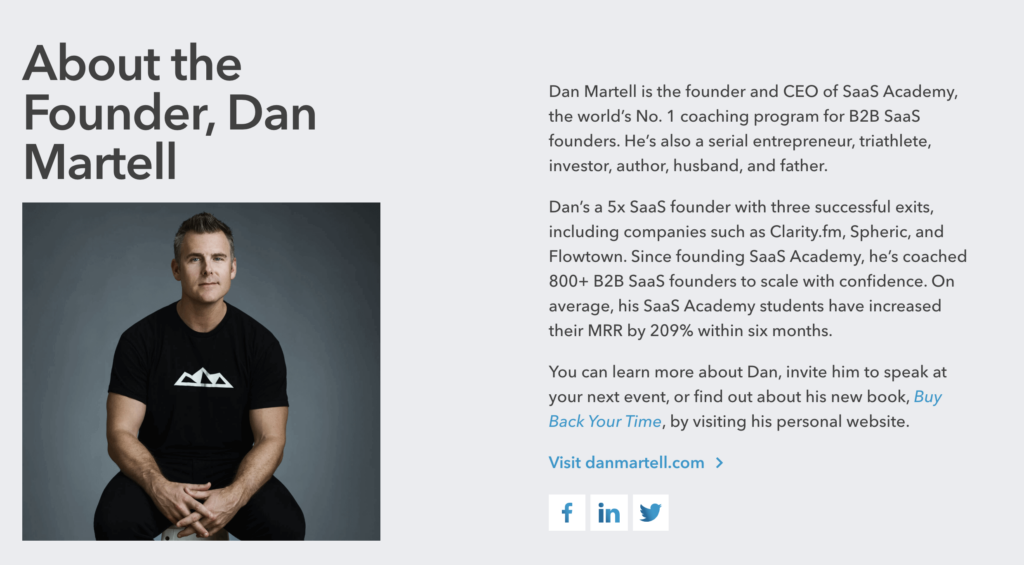
Nancy Duarte
Nancy Duarte’s CEO blurb on the site for Duarte, her communications firm, is an incredible example of an executive professional bio. When you’re an executive, all eyes are on you. Even more so when your company is named after you! It’s normal to base your opinion of a company on what you know of the executive team. Nancy caters to this perception with a bio that emphasizes her professional qualifications as well as various interesting facts. It makes you think: “wow, I’d trust a company with her at the helm!”
When you have as many amazing achievements as Nancy Duarte, you can pick and choose what you open your bio with. She goes with her six books and her position within the company, establishing her brand as an author and executive. Her bio develops her brand with the added connotations of consultant, speaker, and University Lecturer.
Notice the list of media organizations who have featured her takes up a lot of space. This kind of name-dropping plays a big role in professional bios, especially for executives. Keep in mind that people perusing the Duarte website are thinking about making what could be a very expensive investment in professional training or consulting. Whenever money is involved, well-established credentials are of utmost importance. Nancy isn’t just showing off–she’s letting potential customers know her methods are well-attested.
After her long list of accomplishments, Nancy explains what her company does that is so unique in one simple sentence. Explaining your area of expertise in a single mission-oriented statement brings readers back to the why of your bio. Why are they reading about you? Because you have something to offer them. What do you do that other people don’t and what drives you? Always try to squeeze this information into your bio. Career highlights are and credentials are essential, but so is expressing what makes you different. We’ve got an amazing podcast episode about storytelling with Nancy Duarte that you can listen to right here.
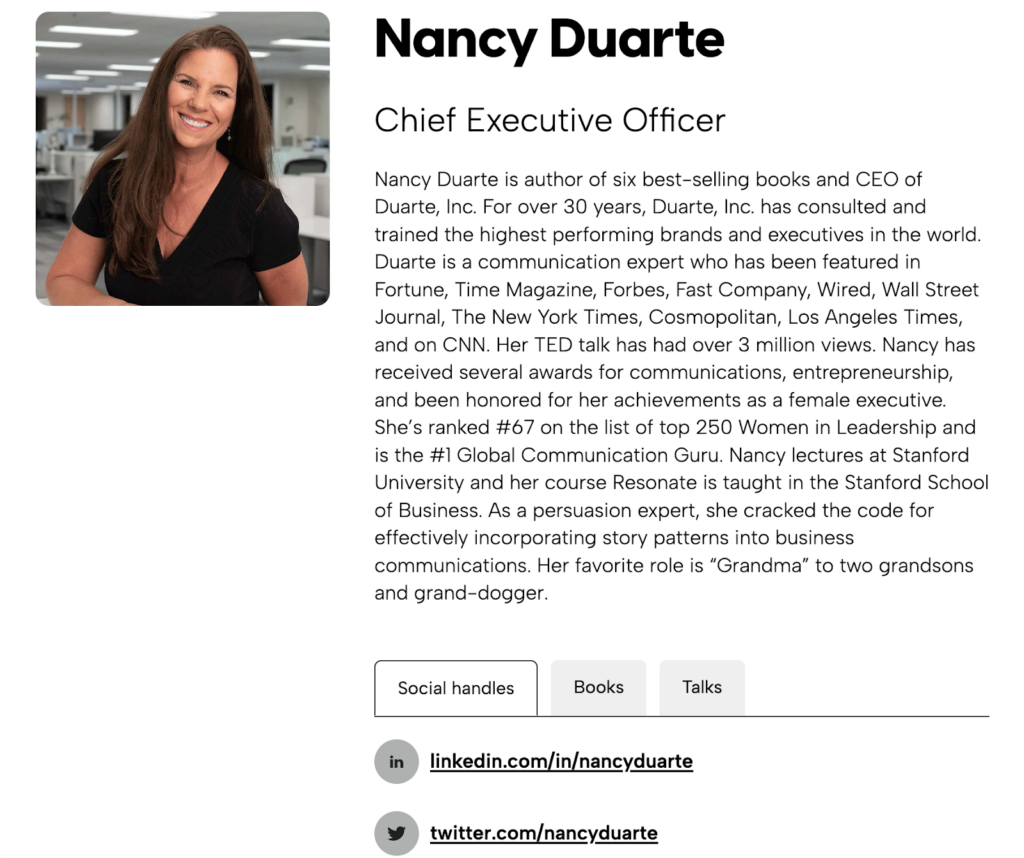
Anne Marie Anderson
Anne Marie Anderson is a woman of many talents. After a successful career in broadcasting, she started applying sports coaching expertise to corporate leadership. Her methodologies led her to become an incredibly successful speaker. Her professional speaker bio for a women’s leadership symposium is a great example of how to communicate the arc of your career alongside your expertise. Even if you’re not a motivational speaker, you likely have made or plan to make a career pivot at some point in your life. When that happens, your qualifications in one field may not seem immediately relevant to the next. If you simply list off bullet points from your resume, readers of your bio could turn skeptical. Your professional bio should solve this problem by connecting the dots.
Because Anne Marie’s bio is oriented toward a speaking presentation, she focuses on the subject of her talk. She describes the transformation her keynote offers the audience in simple but inviting terms. This kind of “teaser” makes people excited for her talk and interested in how they too can achieve that transformation. Then she explains how “Building an Audacious Mindset” rests on the methodology she learned behind the scenes of her sports broadcasting career–connecting the dots between her two career fields.
If you want more insights into making this kind of career pivot, we’ve got you covered! Anne Marie talked to our team about her amazing career and “building an audacious mindset” on the podcast right here.
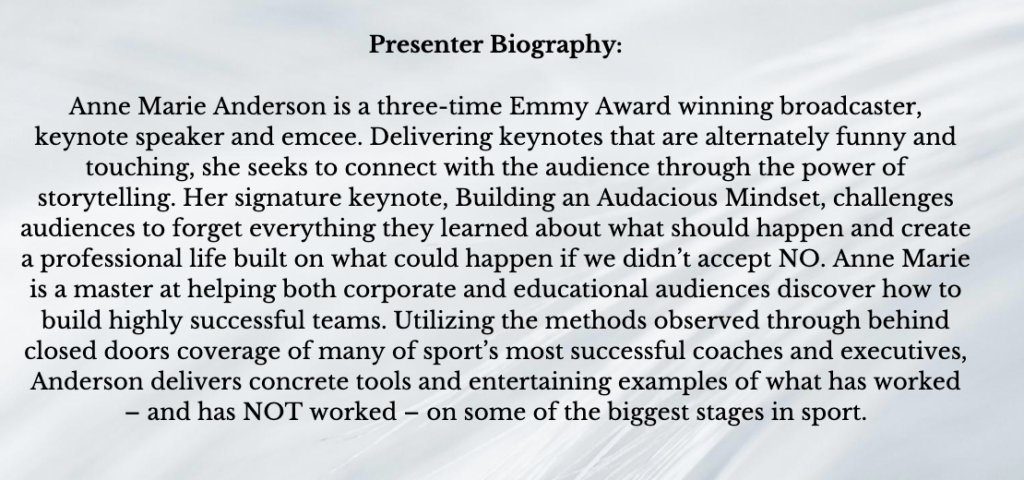
Ty Bennett
The next two professional bio examples we’re covering today are applicable to your personal website or LinkedIn profile. (LinkedIn profiles have a generous allowance of 2,600 characters or about 370 words.) In these situations you can really let the creative juices flow and tell your story. You also have the comfort and confidence of knowing your reader wants to know all about you. They aren’t looking to learn about your company, or an event, or somebody else whose name is on the same page. They want to know about you and how you can help them.
Our first exemplar, Ty Bennett, has a personal website oriented toward his speaking and leadership training services. He begins with prestigious qualifications that showcase the variety and extent of his entrepreneurial career. When you’re a solopreneur who offers a service like speaking or consulting, it’s important to back up your qualifications. Testimonials are a straightforward way to do just that. Ty somewhat humorously arranges his at the top of his bio. He goes into more details about his past clients in the second paragraph after explaining the impact of his groundbreaking leadership methodology.
He finishes off with a quick descriptor of his personal life and a short explanation of his mission. This rounds out his longer bio with a reminder of what’s important. When in doubt, it’s always a good idea to end your bio on a more personal, engaging note. No matter how many amazing awards you’ve won, your audience wants to know what really drives you. In Ty’s case, that’s clearly his family and a passion for cutting-edge leadership strategies.
Ty has been a guest on our podcast a couple times before. We highly recommend his tips for speaking 100 times a year!
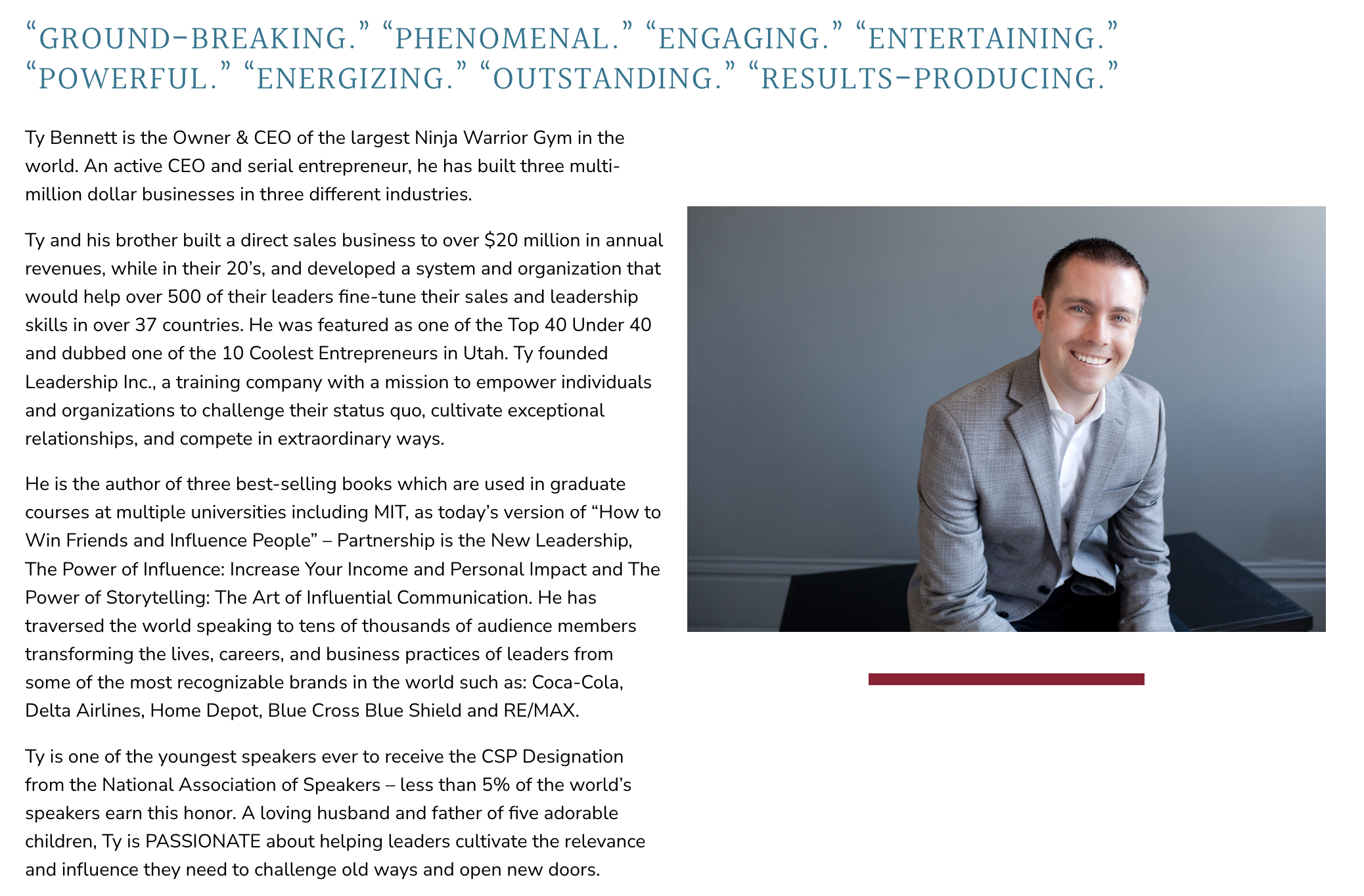
Find Out Exactly How Much You Could Make As a Paid Speaker
Use The Official Speaker Fee Calculator to tell you what you should charge for your first (or next) speaking gig — virtual or in-person!
Ryan Holiday
Ryan Holiday’s personal website is oriented toward his career as a writer. Unsurprisingly, it reads like a story–from his college dropout experience to his ranch in Texas. You’ll notice right away he talks a lot about his blog and his email list in his bio. These are his main way of connecting with readers…and potential customers.
If you have one product or platform that generates most of your followers or customers, emphasize it in your bio. Remember, your bio is probably the first touchpoint the reader has with your personal brand. You shouldn’t turn it into a sales pitch, but emphasize whatever one thing it is you want someone to do after reading your bio. For Ryan, that’s signing up for his email list! He makes this call to action easy peasy by including a newsletter form below this bio.
Ryan is a speaker as well as a writer, and he talked about merging these two occupations On Our Podcast. Give it a listen if you’re interested in becoming a multifaceted entrepreneur!
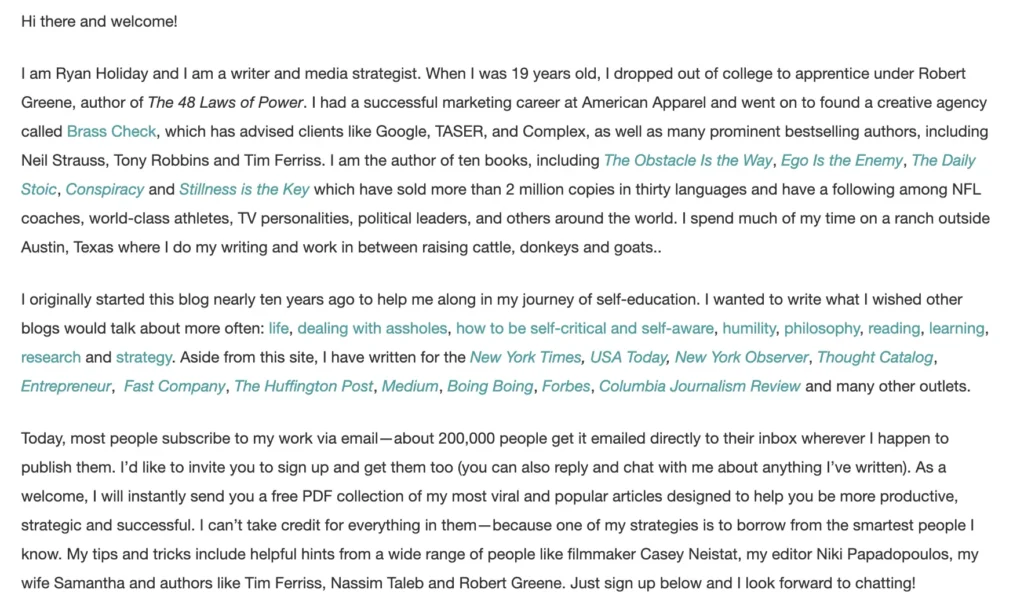
Conclusion
Writing a professional bio is an important skill for executives, mid-level employees, and entry-level professionals alike. With the help of these professional bio examples, you can craft your own stellar bio for any occasion. The most important advice we can give? Keep your audience in mind and tell a story. Stories are almost always a surefire way to make a good first impression. And most importantly, they help your personal brand remain fixed in your readers’ memory.

